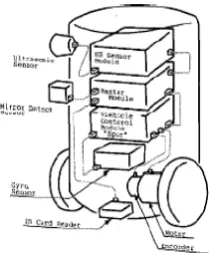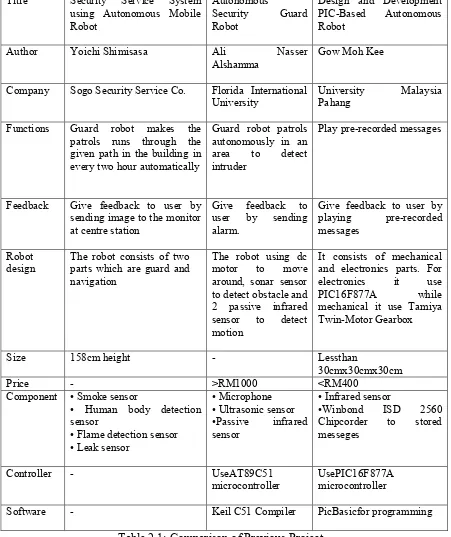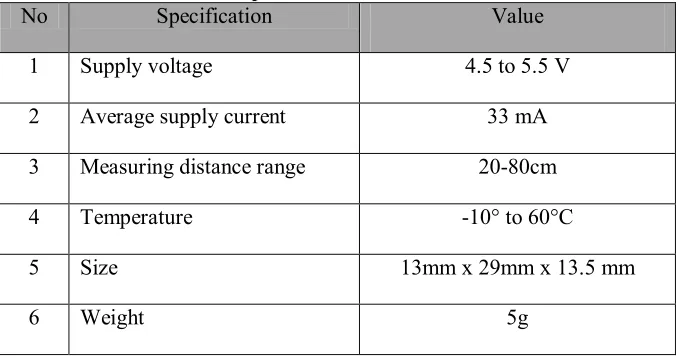i “ I hereby declare that I have read through this report entitle “Smartphone controlled Mobile Security Robot ” and found that it has comply the partial fulfilment for awarding
the degree of Bachelor of Mechatronics Engineering”.
Signature : ...
Supervisor’s Name : ...
ii SMARTPHONE CONTROLLED MOBILE SECURITY ROBOT
DNASH KUMAR A/L MOHAN
A report submitted in partial fulfilment of the requirements for the degree
of Bachelor of Mechatronics Engineering
Faculty of Electrical Engineering
UNIVERSITI TEKNIKAL MALAYSIA MELAKA
iii I declare that this report entitle “Smartphone Controlled Mobile Security Robot” is the
result of my own research except as cited in the references. The report has not been accepted for any degree and is not concurrently submitted in candidature of any other
degree.
Signature : ...
Name : ...
iv I dedicate this research work to my supervisor, Mr. Ma Tien Choon who teach and guide
v ACKNOWLEDGEMENT
First of all, I would like to thank to God because I managed to complete the Final Year Project report on time, without face any difficult problem.
I want to thank to both of my parents, En.Mohan and Pn.Manimekala A/P Beeman and my entire family member who not stop encouraging me and always be there for me when I need them.
I will never forget all of their hard work in supporting me especially in financial aspect. Without them I will not be able to complete my FYP here. In order to complete this report, I had done a lot of researches from various types of source. I had to counter with journals, books, magazines and internet to understand and get the larger view of my project. I also had consulted with many people, researchers, and academician in order to make my project more success. They have played important role in contributed towards my understanding and thought.
In particular, I wish to express my sincere appreciation to my main project supervisor, En. Ma Tien Choon, for him help encouragement, guidance critics and friendship. Without him continuing support and interest, this project would not have been same as presented here.
Last but not least, my fellow friends should also be recognized for their support. My sincere appreciation also extends to all my classmates and others who have provided assistance at various occasions. Their views and tips are useful indeed. Unfortunately, it is not possible to list all of them in this limited space.
vi ABSTRACT
vii ABSTRAK
viii
2.2 Review of previous project related with “Mobile security robot” 4
2.2.1 Overview 4
2.2.2 Security service system using Mobile Robot by Yoichi Shimosasa 4
2.2.3 Security Guard Robot by Ali Nasser Alshamma 6
ix
2.3 Comparison Between previous projects 8
2.4 Sensor selection for obstacle avoid 9
2.4.1 Infrared Distance Sensor 9
3.2.1 Block diagram of smart-phone controlled mobile security robot 16
3.2.2 Gantt chart 17
3.2.3 Research Process 17
3.3 Milestone 2: Design of Mechanical Structure of mobile robot 18
3.3.1 Flow-chart of Mechanical design 18
3.3.2 Mechanical structure of mobile security robot in Solid work and actual 19
3.4 Milestone 3: Develop programming and simulation for the project 20
3.4.1 Programming 20
3.4.2 Simulation 20
3.4.3 Programming Flow-chat (Mobile Robot) 21
3.5 Milestone 4: Design of Electronic circuit 23
3.5.1 Electronic circuit design in PROTEUS and actual circuit 24
3.6 Milestone 5 – Fabricate the project hardware 25
3.7 Milestone 6 – Smart phone controlled-based mobile security robot Interface 26
3.8 Design of Experiment (DOE) 27
3.8.1 Experiment 1: Analyze the battery durability 27
3.8.2 Experiment 2: Accuracy test for IR sensor 28
3.8.3 Experiment 3: Analyze sensitivity of IR sensor due to different colour of
obstacle 29
3.8.4 Experiment 4: Determine angle of coverage area of PIR sansor 30
3.8.5 Experiment5: Determine the maximum distance detecting motion of PIR
x
4 RESULT AND DISCUSSION 32
4.1 Introduction 32
4.2 Result of Battery Analysis 32
4.2.1 Result of Experiment 1 33
4.3 Result IR Sensor Analysis 35
4.3.1 Result of Experiment 2 35
4.3.2 Result of Experiment 3 37
4.4 Result of PIR Sensor Analysis 38
4.4.1 Result of Experiment 4 38
4.4.2 Result of Experiment 5 40
4.5 Discussions 42
5 CONCLUSION AND RECOMMENDATION 44
5.1 Conclusion 44
5.2 Future Work 45
REFERENCES 46
xi LIST OF TABLES
TABLE TITLE PAGE
2.1 Comparison of Previous Project 8
2.2 Technical Specifications of Infrared Distance Sensor 9
2.3 Technical Specifications of Ultrasonic Distance Sensor 10
2.4 Technical Specifications of Laser Sensor 11
3.1 Electronic circuit design in PROTEUS and actual circuit 24
4.1 Comparison of Battery for Mobile Security Robot 32
4.2 Battery Consumption over Time 33
4.3 Result from Experiment 1of IR Sensor 35
4.4 Result from Experiment 3 of IR Sensor 37
4.5 Result of Experiment 4 39
xii LIST OF FIGURES
FIGURE TITLE PAGE
1.1 Traditional Security System 2
1.2 Proposed Security System 2
2.1 Robot Height 4
2.2 Navigation Parts 5
2.3 PIC Based Mobile security robot 7
2.4 Infrared Distance Sensor 9
2.5 Ultrasonic Distance Sensor 10
2.6 Laser Sensor 11
3.2 Block diagram of smart-phone controlled –based mobile robot 16
3.3 Research Process Flow-chart 17
3.4 Mechanical Design Flow-chart 18
3.5 Solid work design of mechanical structure of Mobile security robot 19 3.6 Actual structure of Mobile security robot 19
3.7 Programming and Simulation Flowchart 20
3.8 Programming Flow-chart 21
xiii
3.10 Electronic Circuit Flow-chart 23
3.11 Electronic System Overview 24
3.12 Hardware Flow-chart 25
3.13 Smart phone controlled-based mobile security robot Interface 26
3.14 Experiment Setup 27
3.15 GUI for voltage data recorder 27
3.16 Distance of Obstacle from IR Sensor 28
3.17 Colour Obstacle Detection 29
3.18 PIR Sensor Coverage Area 30
3.19 Distance measurement of PIR sensor 31
4.1 Graph Voltage (V) Vs. Time (Min) 34
4.2 Graph Voltage (V) Vs Distance (Cm) 36
4.3 Graph Distance (cm) Vs. Obstacle Color 38
4.4 Graph Output Signal vs. Angle (θ) 39
xiv LIST OF ABBREVIATIONS
IR – Infra red
PIR- Passive infrared MSR-Mobile security robot Led-Light emitting diode
xv LIST OF APPENDICES
APPENDIX TITLE PAGE
A Detail flowchart of methodology 47 B Gantt chart 48 C Source code of microcontroller 49-52 D Schematic of electronic circuit 53 E Source code of vb2010 54-67 F Smart phone Connect Netbook through teamviewer 68 software
1
CHAPTER 1
1 INTRODUCTION
1.1 Chapter overview
Chapter 1 introduces the general view and background of this project with the title of “smart phone controlled mobile security robot”. This is an individual project and is separated into two major tasks:-
i) To design a mobile security robot.
ii) To control the mobile security robot by using smart-phone via internet.
This chapter is divided into four sections. First section is a general preview of this chapter. The second section gives a simple explanation of the problem statement follow by section three which defines the objectives to achieve throughout the project. The last section described about the scope of the project.
1.2 Problem statement
Nowadays, people pay more attention on home security system in these modern days. This is because living in safe environment has becomes a critical issues for human. For examples, unexpected events like burglary, fire, medical attention and children’s safety. Hence, to overcome this problem, many academic researchers and multinational companies has work together to design a variety of home security system. However, the cost upon purchase and to maintain is high and most of the mid-class community would consider unfavourable to have one installed in their household.
2 A mobile security robot, act as a security patroller in the security system, which capable of recognizing prospective hazards to humans being in advance and can monitor those dead zones of the traditional fixed surveillance system. The mobile security robot can control through smart-phone by using “remote-desktop software” at anytime anywhere. However, the robot will patrol semi-autonomously around specific designed area, capable to detecting human movement and gives feedback to the users. Furthermore, this mobile security robot will give a sense of relief when the user leave their house as they will be able to see what is happening in their homes. However this mobile security robot is constructed economically so that everyone can buy this product and easily to used.
MSR
Figure 1.1: Traditional Security System
3 1.3 Objective
The main objectives of this project are:-
1. To design and establish basic mechanical structure of the robot. 2. To control mobile security robot through smart-phone via internet. 3. To implement communication between laptop and microcontroller.
4. To analyze the passive infrared sensor (PIR) in detection motion and infrared sensor in proximity detection.
1.4 Scope
The scope of this project covers the design, development and testing of the smart phone controlled-based mobile security robot. The scopes include:
4
CHAPTER 2
2 LITERATURE REVIEW
2.1 Introduction
In this chapter, a review of several previous research projects which are related with this project’s purpose and objective is discussed. Thus, a comparison will be made between the previous projects result be displayed in table. However in this chapter also we include a comparison table for sensor chosen for obstacle avoidances.
2.2 Review of previous project related with “Mobile security robot”
2.2.1 Overview
There are various type of mobile security robot has been developed with different features. Each developed of mobile robot has its own pro and cons. 3 papers related to my project were comparing in term of price, size, and intruder detection and user friendliness.
2.2.2 Security service system using Mobile Robot by Yoichi Shimosasa
5 Based on this project has been developed by Sogo Security Services Co in the year of 1999. The purpose of this system is to secure reduction of labor and guard’s safety. This guard robot patrols through the given path in the building in every two hours automatically and at the same time as patrolling, the guard robot sends images and sensor data of each sensor to the monitoring equipment. A security guard, who is usually stayed at the center station, gets the information on monitor together with information from other robots or sensors. In case of anything unusual, the guard will cope with it, remotely from the station, or going to the place. This type of robot gives feedback to user by displaying the actual image. The robot is divided into top and bottom part. The top part is consisted with the guard function, and the bottom part is devoted to autonomous motion and navigation. The guard robot has two driving wheels at left and right of body center, and four casters at front and back to support the body. Encoders are mounted at driving wheels to realize odometer system [1]. The vehicle control module estimates the robot position based on the wheel rotation and optical fiber gyro sensor, and controls the driving wheels. The sensor of the guard is installed on top of the robot. It has smoke sensor, human body detection sensor, flame detection sensor, and leak sensor. The smoke sensor detects smoke by the reflection level of the light. The human body detection sensor detects infrared rays which come out from the human body. The flame detection sensor detects the ultraviolet rays which appear from the flame. The leak sensor detects conductive rate of water [1].Since it consists two parts which are autonomous and guard function part, it requires a lot of space to mount the entire sensor and other component. This result contributes in increasing the size of the robot. The robot become bulky and hard to move around if any obstacle is present in front of it. Furthermore, it become heavy thus makes it patrolling slowly in a certain area and needed longer time to do it task. Compared to the project which smaller in size is making it
6 less weight, stable, moving fast and easily avoid any obstacle whether it big or small so that it can easily move around in small space area.
2.2.3 Security Guard Robot by Ali Nasser Alshamma
7 2.2.4 Design and Development PIC- Based Robot by Gow Moh Kee
University Malaysia Pahang had done a project “Design and Development PIC-Based Autonomous Robot” that was developed in 2008. The robot is equipped with the obstacle-avoidance ability which uses the IR sensors and the robot can play pre-recorded messages. Those pre-recorded messages are stored in the Win bond ISD 2560 Chip order. Firstly the robot will sound "Autonomous robot on" and move forward when power is on. When it senses obstacle at right, it will sound "Obstacle at right, turning left" while when it senses obstacle at left, it will sound "Obstacle at left, turning right". The robot will continue to move forward if no obstacles. If the robot senses the obstacle in front of it, it will sound "Obstacle at front, reversing" and reverse for 2 seconds, then it will turn right before it continues to move forward. The autonomous robot controller board is designed around the PIC 16F877A, which contains 5 Input/output (1/0) ports with 33 I/0 pins. There are two IR sensors on this robot, right IR sensor and left IR sensor. Each IR sensor consist an infrared emitter and an infrared receiver. The infrared emitters are emitting at the frequency generated by the 555 Timer. The robot is designed two layered. The upper layer is the infrared sensor and the ISD 2560 Chip coder. Then the lower layer is the controller board which is attached to the chassis of the robot. In this project, the programming language used is Pic Basic. It used IR sensor to detect obstacle and give signal to microcontroller to instruct the robot to avoid it. It uses PIC16F877A to control all the movement of the robot. Figure 2.14 shows the hardware of the project.
Figure 2.2 :
8 2.3 Comparison Between previous projects
Table 2.1 below shows the conclusion of comparison between previous projects in different characteristics. These 3 projects are focusing on developing the robot that can autonomously move with/without human control. The robots are design to give users information when the sensors of the robots detect.
Title Security Service System
using Autonomous Mobile
Author Yoichi Shimisasa Ali Nasser
Alshamma Gow Moh Kee
Company Sogo Security Service Co. Florida International
University University Pahang Malaysia
Functions Guard robot makes the
Software - Keil C51 Compiler PicBasicfor programming
9 2.4 Sensor selection for obstacle avoid
2.4.1 Infrared Distance Sensor
IR distance sensors are measuring sensor units, composed of an integrated combination of PSD (position sensitive detector), IRED (infrared emitting diode) and signal processing circuit. The variety of the reflectivity of the object, the environmental temperature and the operating duration are not influenced easily to the distance detection because of adopting the triangulation method. This device outputs the voltage corresponding to the detection distance. So this sensor can also be used as a proximity sensor.
Features
1. Less influence on the color of reflective objects 2. Line-up of distance output/distance judgment type
Detecting distance: 10 cm to 80 cm 3. External control circuit is unnecessary 4. Low cost
Technical specifications
Table 2.2 : Technical Specifications of Infrared Distance Sensor
No Specification Value
1 Supply voltage 4.5 to 5.5 V
2 Average supply current 33 mA
3 Measuring distance range 20-80cm
4 Temperature -10° to 60°C
5 Size 13mm x 29mm x 13.5 mm
6 Weight 5g
Figure 2.3 :


